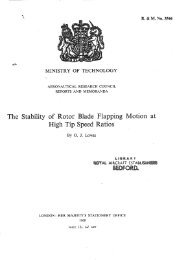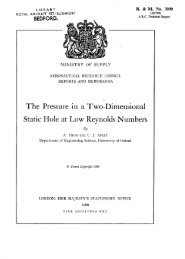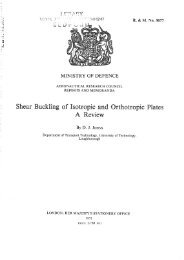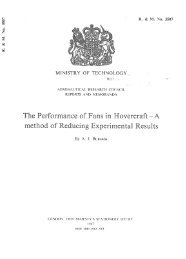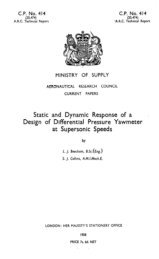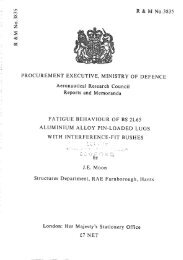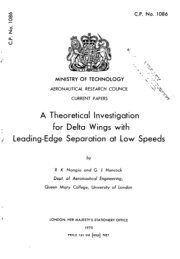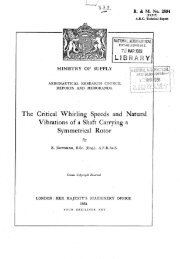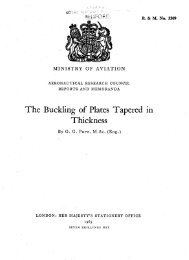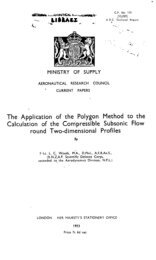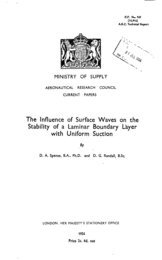A Discussion of Two-Dimensional Turbulent Base Flows - aerade
A Discussion of Two-Dimensional Turbulent Base Flows - aerade
A Discussion of Two-Dimensional Turbulent Base Flows - aerade
You also want an ePaper? Increase the reach of your titles
YUMPU automatically turns print PDFs into web optimized ePapers that Google loves.
The analysis <strong>of</strong> the external flow is essentially a mixed boundary-value problem since, while the section<br />
geometry is given and the growth <strong>of</strong> the boundary layer known at least approximately, the shape <strong>of</strong> the<br />
downstream part <strong>of</strong> the displacement surface - representing the separated region and wake - is not known<br />
at the outset. Instead, in the method <strong>of</strong> Ref. 25, certain restraints are imposed on the pressure distribution<br />
in the initial part <strong>of</strong> the wake so that it should resemble that through a typical region <strong>of</strong> separated flow.<br />
The region downstream <strong>of</strong> a step provided experimental data which could be used to establish the type<br />
<strong>of</strong> restraints necessary. This approach enables the pressure distribution round the section to be determined<br />
as a function <strong>of</strong> the base pressure - which as far as this part <strong>of</strong> the analysis is concerned is a free parameter<br />
as in the usual 'free streamline' theory. The analysis was performed using linear inviscid theory. It is<br />
recognised that this imposes limitations on the generallty <strong>of</strong> the work but it was thought justified from<br />
reasons <strong>of</strong> simplicity at least until further experience was gained.<br />
The analysis <strong>of</strong> the turbulent flow in the wake is aimed at matching the development <strong>of</strong> the wake to<br />
that <strong>of</strong> the external flow. This is not done at each point along the wake but appeal is made, as in the case<br />
studied by Squire and Young, to compatibility at infinity downstream. Since from the analysis <strong>of</strong> the<br />
external flow the pressure distribution is known as a function <strong>of</strong> the base pressure it is a straightforward<br />
matter to estimate the pr<strong>of</strong>ile drag as a function <strong>of</strong> the base pressure simply by evaluating the pressure<br />
drag and skin-friction drag directly. (The restriction to appreciable trailing-edge thickness enables this<br />
to be done more easily than would be the case for a sharp section.) Knowledge <strong>of</strong> the pr<strong>of</strong>ile drag as a<br />
function <strong>of</strong> the base pressure, then defines the asymptotic momentum thickness <strong>of</strong> the wake in terms <strong>of</strong> the<br />
base pressure. It remains to integrate the momentum-integral equation along the wake to provide a<br />
further relation between conditions at separation and those at infinity.<br />
In the analysis <strong>of</strong> Ref. 25 the momentum-integral equation is applied, not to the complete flow in the<br />
wake, but to the part outside the mean dividing streamline through the separated region; the recirculating<br />
flow immediately behind the base is excluded from the integration. A few simplifying approximations<br />
are made in order to integrate the equation but these are thought to be satisfactory at the present state<br />
<strong>of</strong> the art. The approximations are little more serious than those contained in the analysis <strong>of</strong> Squire and<br />
Young, and the treatment <strong>of</strong> the wake in the method <strong>of</strong> Ref. 25 can be regarded as a logical extension <strong>of</strong><br />
their work to cover the case <strong>of</strong> non-zero trailing-edge thickness.<br />
The validity <strong>of</strong> the wake analysis was confirmed to an encouraging degree by measurements <strong>of</strong> the base<br />
pressure on steps, although the comparison was only meaningful within the framework <strong>of</strong> the assumption<br />
that the effect <strong>of</strong> the downstream wall on the pressure field is small. The fact that data from the same<br />
experiments was used in the analysis does not invalidate the comparison. In the case <strong>of</strong> the flow past a<br />
rectangular step the analysis <strong>of</strong> the external flow (which involved empirical information concerning the<br />
pressure distribution downstream <strong>of</strong> separation) plays little part in the determination <strong>of</strong> the base pressure.<br />
It only arises at all, in this case, as far as the length <strong>of</strong> the separated region is concerned and this information<br />
could have been provided by other means (see Ref. 13).<br />
The predicted variation <strong>of</strong> base pressure with Mach number for a long, parallel-sided section, or for a<br />
rectangular step, is shown in Fig. 4. It is noted that with increase <strong>of</strong> Mach number the base-pressure<br />
coefficient falls slightly. The rate <strong>of</strong> decrease is however only about a half <strong>of</strong> that which would occur in<br />
the case <strong>of</strong> the pressure coefficients on the surface <strong>of</strong> an aer<strong>of</strong>oil. The variation <strong>of</strong> Cp with Mach number<br />
indicated by the Prandtl-Glauert law is shown in Fig. 4 for comparison. The more sophisticated com-<br />
pressibility laws indicate an even larger rate <strong>of</strong> decrease <strong>of</strong> the pressure coefficients.<br />
The main application <strong>of</strong> the method is to the prediction <strong>of</strong> the effects <strong>of</strong> section geometry, Reynolds<br />
number, etc., on base pressures. In such exercises the validity <strong>of</strong> the analysis <strong>of</strong> the external flow must be<br />
assumed but this is likely to be as good as that <strong>of</strong> the flow model as a whole.<br />
In Ref. 25 some calculations were presented showing the effect <strong>of</strong> boat-tailing on base pressure. The<br />
general effect, that is a rapid increase <strong>of</strong> base pressure even for moderate degrees <strong>of</strong> boat-tailing, has now<br />
been confirmed by tests carried out at Cambridge University 24. Calculations were also presented showing<br />
the effect on an aer<strong>of</strong>oil pressure distribution <strong>of</strong> trailing-edge truncation using an aer<strong>of</strong>oil <strong>of</strong> RAE.103<br />
section for an example. <strong>Two</strong> cases, with different degrees <strong>of</strong> blunting, were considered and tkese were<br />
compared with the basic RAE.103 section. To make the comparison more meaningful, it was assumed<br />
10



